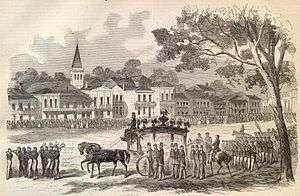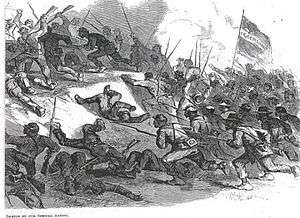Andre Cailloux

Andre Cailloux (1825 – May 27, 1863) was one of the first black officers in the Union Army to be killed in combat during the American Civil War. He died heroically during the unsuccessful first attack on the Confederate fortifications during the Siege of Port Hudson, Louisiana. Accounts of his heroism were widely reported in the press, and became a rallying cry for the recruitment of African Americans into the Union Army.
His reputation as a patriot and martyr long outlived him. In an 1890 collection of interviews, Civil War veteran Colonel Douglass Wilson said, "If ever patriotic heroism deserved to be honored in stately marble or in brass that of Captain Caillioux deserves to be, and the American people will have never redeemed their gratitude to genuine patriotism until that debt is paid."[1]
Early life
Born a mixed-race slave in Louisiana in 1825, Cailloux lived his entire life in and around New Orleans. As a young man, Cailloux had been apprenticed in the cigar-making trade. He was owned by members of the Duvernay family until 1846. His petition at age 21 for manumission was supported by his master and was granted by an all-white police jury in the city of New Orleans.
There was an established community of free people of color in New Orleans, who were descended from both European and African Creoles (born in North America). This group became established during the French colonial years and enjoyed some rights as a third class between the white colonists and the majority of enslaved Africans. In New Orleans culture under the plaçage system, white men took women of color as common-law wives. Sometimes they acknowledged their mixed-race children and paid for their education, especially of sons, or arranged apprenticeships for adult skills. Sometimes they settled property on them.
In 1847, Cailloux married Félicie Coulon, a free Creole of color. Although born into slavery, she had been freed by her mother paying her purchase price to her master. Cailloux and Coulon had four children born free, three of whom survived to adulthood.
Félicie's mother Feliciana had been an enslaved mulatto woman. for several years, after she had already borne Félicie, she was held by and served as the common-law wife of her master Valentin Encalada, a white planter. Félicie was Encalada's "property" as the child of her mother. (This was according to the principle of partus sequitur ventrem in slave law.) Feliciana bought her daughter's freedom from Encalada in 1842.
Life in freedom
Upon gaining his freedom, Cailloux earned his living as a cigar maker. Prior to the beginning of the Civil War, he established his own cigar-making business. Though his financial circumstances were modest, Cailloux became recognized as a leader within the community of free people of color in New Orleans.
An avid sportsman, Cailloux was admired as one of the best boxers in the city. He was also an active supporter of the Institute Catholique, a school for orphaned black children. It also taught the children of free people of color. After his manumission, Cailloux learned to read, probably with the assistance of the teachers at the Institute Catholique. He became fluent in both English and French.
By 1860, Cailloux was a well-respected member of the 10,000 "free men of color" community in New Orleans. At the time, New Orleans was the largest city in the South, and the sixth-largest city in the United States, with a population of about 100,000.
American Civil War
Confederate States Army
At the outbreak of the Civil War in 1861, Cailloux was commissioned as a lieutenant in the Native Guard, a Confederate regiment organized to defend the city of New Orleans. Free men of color had participated in the local militia since the time of French colonial rule. He was one of the first black officers of any North American unit.[2]
The Native Guard was made up entirely of free men of color who resided in and around New Orleans. Though the regiment was organized primarily as a public relations move by the Confederate government of the state of Louisiana, which provided no allowances for uniforms or equipment, Cailloux took his responsibilities seriously. His unit was observed to be well drilled and well trained.
The Confederate Native Guard were never called to active duty. Needing more soldiers, the Confederate Congress passed a law to establish conscription and reassigned its white officers to newly formed white units, disbanding the Guard in February 1862. Two months later, Union Admiral David Farragut captured the city of New Orleans in April 1862.
Union Army
Union General Benjamin F. Butler, military commander of the Department of the Gulf, made his headquarters in New Orleans. In September 1862 he ordered the organizing of an all-black Union Army 1st Louisiana Native Guard regiment. Unlike the Confederate unit, this regiment had a minority of free men of color; the great majority were African Americans who had escaped from slavery and joined Union forces.[3]
Andre Cailloux joined this regiment and was commissioned as captain of Company E. His company was considered one of the best drilled in the Native Guard. Cailloux gradually earned the respect of Colonel Spencer Stafford, the white officer who commanded the regiment. When General Nathaniel P. Banks replaced Butler as Commander of the Department of the Gulf in December 1862, he brought with him an additional 30,000 troops, bringing the total troop strength under his command to 42,000. They were being fortified for the regional assault against Vicksburg, Mississippi.
By this time, the all-black Native Guard had grown to three regiments, as slaves continued to escape to Union lines to join the cause of fighting their former masters. Although the line officers (lieutenants and captains) were black, including future Governor P. B. S. Pinchback, a Company Commander of the 2nd Regiment, the commanding officers (colonels, lieutenant colonels, and majors) were white. Banks set out to replace all black officers with white ones, and generally accomplished this with the 2nd and 3rd Regiments, but not with the 1st Regiment, in which Andre Cailloux served.
The 1st Regiment of the Native Guard was assigned primarily to fatigue duty (chopping wood, digging trenches) until May 1863, when Banks moved most of his army (35,000 men) into a position to surround the Confederate fortifications at Port Hudson, Louisiana. Port Hudson was a strategically located fort on a bend in the Mississippi River just 20 miles (32 km) north of Baton Rouge. At the time, the Confederacy still controlled the 200-mile stretch of the Mississippi River between Vicksburg, Mississippi, in the north and Port Hudson in the south. The Union wanted to gain control of Vicksburg, which had a strategic position on a bluff, in order to control the Mississippi.
While General Ulysses Grant laid siege to Vicksburg, Banks conducted the siege of Port Hudson.
Siege of Port Hudson

On May 27, 1863, Banks launched a poorly coordinated attack on the well-defended, well-fortified Confederate positions at Port Hudson. As part of the attack the first day, Cailloux was ordered to lead his company of 100 men in an almost suicidal assault against sharpshooting Confederate troops. Despite his company suffering heavy casualties, Cailloux, shouting encouragement to his men in French and English, led several charges. On his last charge, a Minié ball tore through his arm, leaving it hanging useless at his side. Severely wounded, Cailloux continued to lead the charge until a Confederate artillery shell killed him.
His actions were described by Rodolphe Desdunes, whose brother, Aristide, served under Cailloux:
The eyes of the world were indeed on this American Spartacus [Cailloux]. The hero of ancient Rome displayed no braver heroism than did this officer who ran forward to his death with a smile on his lips and crying, "Let us go forward, O comrades!" Six times he threw himself against the murderous batteries of Port Hudson, and in each assault he repeated his urgent call, "Let us go forward, for one more time!" Finally, falling under the mortal blow, he gave his last order to his attending officer, "Bacchus, take charge!" If anyone should say the knightly Bayard did better or more, according to history, he lies.[4]
Banks asked for a truce the next day, which was granted by the Confederate commander Franklin Gardner, so that Union troops could recover their dead from the field of battle. But rebel sharpshooters kept the Union soldiers from collecting black casualties.[5] Cailloux's decomposing body lay on the ground for 47 days until Port Hudson finally surrendered to Banks on July 9, 1863.
Most of the Union dead were buried in the area. This was later established as Port Hudson National Cemetery. In 1974 the cemetery was designated as a National Historic Landmark.
Funeral
Cailloux's remains were recovered and returned to New Orleans. The story of the captain's heroism had preceded this. When his funeral was held in the city on July 29, 1863, Cailloux was honored by a long procession and thousands of attendees. His widow Felicie had asked Father Claude Paschal Maistre to officiate. Born in France, he was the only Catholic priest in the diocese to support the abolition of slavery. Cailloux was buried in Saint Louis Cemetery. His heroism achieved mythic proportions during the Civil War and was frequently recounted. He was often referred to as example by recruiters of black soldiers and proponents for using them in battle.
After Cailloux's death, his widow, Félicie, struggled to receive the financial benefits promised to veterans by the United States Government. After several years of effort, she received a small pension, but she died in poverty in 1874. She was working at the time as a domestic servant for the Catholic priest who had preached the eulogy at her husband's funeral.
See also
References
- ↑ Albert, Octavia V. Rogers (1890). The House of Bondage, or, Charlotte Brooks and Other Slaves, Original and Life-Like, As They Appeared in Their Old Plantation and City Slave Life. New York: Hunt & Eaton. pp. 131–132. Retrieved 2014-02-09.
- ↑ Louisiana Fast Facts and Trivia
- ↑ Terry L. Jones (2012-10-19) "The Free Men of Color Go to War", The New York Times, Opinionator blog; Retrieved on 2012-12-18.
- ↑ Desdunes, Rodolphe Lucien. Nos Hommes et Notre Histoire. Montreal: Arbour & Dupont, 1911. as translated in Bell, Caryn Cossé, "Rappelez-vous concitoyens": The Poetry of Pierre-Aristide Desdunes, Civil War Soldier, Romantic Literary Artist, and Civil Rights Activist, University of Massachusetts Lowell
- ↑ Faust, Drew (2008). This Republic of Suffering. New York: Vintage Books. p. 50.
Further reading
- Holden, Randall G., Futile Valor, Baton Rouge, Louisiana: MCG Publishing, 1998.
- Ochs, Stephen J., A Black Patriot and a White Priest: André Cailloux and Claude Paschal Maistre in Civil War New Orleans, Baton Rouge: Louisiana State University Press, 2000.
- Ochs, Stephen J. (July 31, 2015). "The Rock of New Orleans". The New York Times. Retrieved March 22, 2017.
External links
- "The Siege of Port Hudson", Hardy Family Genealogical Site
- Andre Cailloux at Find a Grave